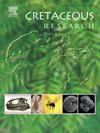下白垩世克拉托组最早寄生性甲虫(拟粉甲总科:拟粉甲科)及鞘翅目概述
IF 1.7
3区 地球科学
Q1 GEOLOGY
引用次数: 0
摘要
描述了巴西东北部下白垩纪克拉托组的一种甲虫化石。†Cratovorus archaicus gen. 11 . et sp. 11 .被自信地归入高度特化的拟甲目Ripiphoridae的Ripidiinae亚科,Ripidiini部落。这是目前已知最早的这一科化石,也是第一个在南半球被描述的中生代拟黄目物种。其特化形态与现存的Ripidiini雄性相似,并与该部落有几个共同的外形特征,这强烈表明†Cratovorus archaicus gen. 11 . et sp. 11 .已经有寄生幼虫。它也与该家族的其他白垩纪属相似,这些属可能与该矿床中发现的现存的Blattodea谱系有关。内寄生的发展暗示了其在Ripidiinae中的位置,使其成为鞘翅目中最早的寄生记录。本文提供了从克拉托组描述的鞘翅目和从该矿床中提到的命名的鞘翅目的注释列表。讨论了克拉托组甲虫种类对了解代表性谱系演化的重要性。本文章由计算机程序翻译,如有差异,请以英文原文为准。
The earliest parasitoid beetle (Tenebrionoidea: Ripiphoridae) and an overview of Coleoptera from the Lower Cretaceous Crato formation
A fossil beetle species from the Lower Cretaceous Crato Formation of northeastern Brazil is described. †Cratovorus archaicus gen. nov. et sp. nov. is assigned with confidence to the subfamily Ripidiinae, tribe Ripidiini, of the highly specialized tenebrionoid Ripiphoridae. It is the earliest known fossil of this family at present, and also the first described Mesozoic species of Tenebrionoidea from the Southern Hemisphere. Its specialized morphology is similar to extant males of Ripidiini and it shares several apomorphies with this tribe, which strongly suggests that †Cratovorus archaicus gen. nov. et sp. nov. had already parasitic larvae. It is also similar to some other Cretaceous genera of the family, which were likely associated with an extant lineage of Blattodea also found in the deposit. Endoparasitic development as implied by the placement in Ripidiinae makes this the earliest record of parasitoidism in Coleoptera. An annotated list of Coleoptera described from Crato Formation and those mentioned from this deposit as nomina nuda is provided. The importance of beetle species from Crato Formation for understanding the evolution of the represented lineages is discussed.
求助全文
通过发布文献求助,成功后即可免费获取论文全文。
去求助
来源期刊

Cretaceous Research
地学-地质学
CiteScore
4.10
自引率
19.00%
发文量
235
审稿时长
12 weeks
期刊介绍:
Cretaceous Research provides a forum for the rapid publication of research on all aspects of the Cretaceous Period, including its boundaries with the Jurassic and Palaeogene. Authoritative papers reporting detailed investigations of Cretaceous stratigraphy and palaeontology, studies of regional geology, and reviews of recently published books are complemented by short communications of significant new findings.
Papers submitted to Cretaceous Research should place the research in a broad context, with emphasis placed towards our better understanding of the Cretaceous, that are therefore of interest to the diverse, international readership of the journal. Full length papers that focus solely on a local theme or area will not be accepted for publication; authors of short communications are encouraged to discuss how their findings are of relevance to the Cretaceous on a broad scale.
Research Areas include:
• Regional geology
• Stratigraphy and palaeontology
• Palaeobiology
• Palaeobiogeography
• Palaeoceanography
• Palaeoclimatology
• Evolutionary Palaeoecology
• Geochronology
• Global events.
 求助内容:
求助内容: 应助结果提醒方式:
应助结果提醒方式:


